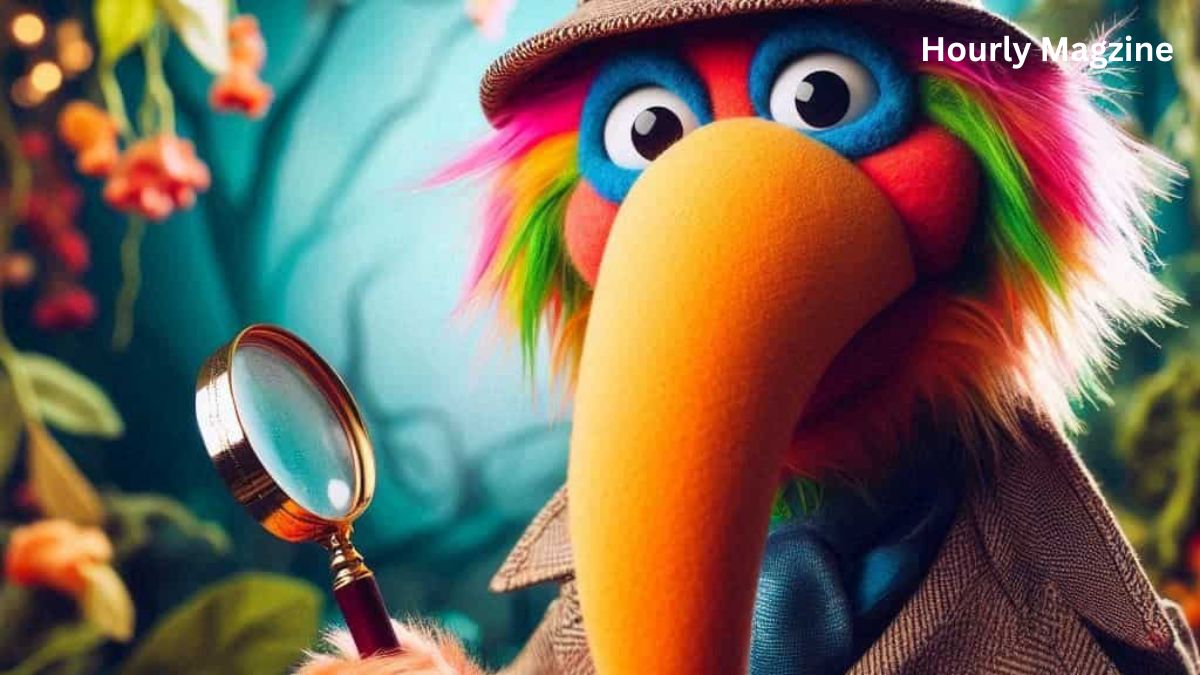ENTERTAINMENT
Why Every Child Needs a Muppet with a Long Hooked Beak in Their Lives

Imagine a world filled with colorful characters that can spark joy, laughter, and learning in the hearts of children. Enter the realm of Muppets—a delightful universe where puppetry meets storytelling. Among these whimsical beings is a standout figure: the Muppet with a long hooked beak. This quirky creation not only entertains but also plays an essential role in shaping young minds.
Muppets have been part of childhood for generations, offering valuable lessons cloaked in fun. They teach empathy, friendship, and creativity while making every moment memorable. But why does every child need their very own Muppet with a long hooked beak? Let’s explore how this charming character impacts children’s lives and why he deserves a place in homes everywhere!
The Creation and Evolution of the Iconic Muppet Character: Big Bird
Big Bird, the beloved giant yellow Muppet, first took flight in 1969 on “Sesame Street.” Created by puppeteer Caroll Spinney, this character quickly became a symbol of childhood innocence and curiosity.
With his long hooked beak and towering height, Big Bird stood out as both a friend and mentor to children navigating their early years. He embodied warmth and kindness, making learning fun.
Over time, Big Bird evolved beyond just a puppet. His adventures addressed complex topics like friendship, loss, and acceptance. The character’s gentle approach helped many kids understand difficult emotions.
As the show progressed through decades, Big Bird adapted to reflect societal changes while maintaining his core values. His presence is not just nostalgic; it continues to resonate with new generations of children discovering the joys of learning through play.
You may like also:Decoding the Sound of an Angry Grunt nyt: What New York Times Readers Are Really Feeling
The Importance of Representation in Children’s Media
Representation in children’s media matters deeply. When children see characters that reflect their own experiences, they feel seen and valued. This visibility fosters a sense of belonging.
A Muppet with a long hooked beak can serve as an engaging example. Such unique features spark curiosity and promote acceptance of differences. Kids learn that diversity is beautiful and essential.
Moreover, representation helps dismantle stereotypes. Characters like Big Bird teach kids about empathy and understanding others’ perspectives. They encourage conversations about identity and individuality.
When children encounter diverse characters, it opens doors to discussions on race, ability, gender, and culture. These dialogues are crucial for developing well-rounded individuals who embrace the world’s richness.
Through meaningful representation in media, we prepare our future generations for a more inclusive society where every child feels empowered to express themselves authentically.
Lessons Learned from Big Bird and Other Muppets with Unique Characteristics
Big Bird, with his enormous frame and gentle demeanor, teaches children about kindness. He shows that being different is something to celebrate. His curiosity encourages kids to explore the world around them.
Other Muppets with unique traits share valuable lessons too. Elmo’s innocence highlights the importance of friendship. Meanwhile, Cookie Monster’s love for cookies serves as a playful reminder about moderation in treats.
These characters spark conversations about emotions and acceptance. They create opportunities for young viewers to reflect on their own feelings while navigating friendships.
Muppets also illustrate problem-solving skills through imaginative stories. Their adventures demonstrate how teamwork can overcome challenges.
Each character, including those with long hooked beaks, brings forth essential life lessons wrapped in fun and laughter. This combination captivates children’s hearts while subtly teaching resilience and empathy along the way.
How Muppets Foster Social and Emotional Development in Children
Muppets, with their quirky personalities and relatable stories, play a vital role in children’s social and emotional growth. Characters like Big Bird not only entertain but also teach valuable lessons about friendship, empathy, and understanding.
When children watch Muppets interact with one another, they learn how to navigate their own relationships. These characters model kindness and conflict resolution in ways that resonate deeply with young viewers.
Moreover, Muppets often express a range of emotions—joy, sadness, confusion—which helps kids identify and articulate their feelings. This emotional literacy is crucial for developing healthy communication skills.
Role-playing games featuring Muppet friends can also encourage creativity while allowing children to explore different perspectives. By stepping into the shoes of these beloved characters, kids gain confidence in expressing themselves socially.
The bright colors and catchy songs are just the icing on the cake; it’s the heartwarming messages that truly nurture social connections among little ones.
The Power of Play: Using Muppets to Spark Imagination and Creativity
Play is a vital part of childhood. It fuels imagination and allows kids to explore the world around them. What better way to ignite that creativity than through Muppets?
These whimsical characters, like a Muppet with a long hooked beak, inspire children to think outside the box. They encourage storytelling, role-playing, and even problem-solving.
When kids engage with their favorite puppets, they step into new worlds. Each character offers unique traits and perspectives that spark innovative ideas. The interaction becomes an adventure—one where anything is possible.
Crafting narratives alongside these beloved figures helps develop critical thinking skills too. Children learn how to express themselves while diving deep into imaginative play.
With each laugh and silly moment shared with a Muppet friend, creativity flourishes in boundless ways. This playful engagement shapes not only their present but also lays the foundation for future innovation.
Beyond Entertainment: Educational Benefits of Watching M
Muppets are not just fun and games. They offer significant educational benefits that can enrich a child’s learning experience.
For starters, characters like Big Bird introduce foundational concepts such as numbers, letters, and social skills in an engaging way. Children absorb these lessons without even realizing it.
Moreover, the diverse cast of Muppet characters promotes critical thinking about differences and similarities among individuals. This fosters understanding and acceptance from a young age.
Additionally, the humor woven into their antics encourages language development. Kids learn new vocabulary while laughing at silly situations or clever wordplay.
Interactive segments often prompt children to participate actively rather than passively consume content. This engagement enhances retention of information while making learning feel like playtime—an essential ingredient for effective education in early childhood.
conclusion:
The presence of a Muppet with a long hooked beak, much like Big Bird, offers children an invaluable companion in their formative years. These unique characters not only entertain but also serve as crucial tools for teaching important life lessons. They encourage imagination and creativity while fostering social and emotional growth.
When kids see these vibrant personalities on screen, they learn about diversity and acceptance. The quirks that may seem odd at first become symbols of uniqueness to celebrate rather than shy away from. This fosters empathy in young minds.
Moreover, the educational benefits are undeniable. Engaging with Muppets can enhance language skills, develop critical thinking abilities, and inspire curiosity about the world around them. Children don’t just watch; they interact and learn through play.
Introducing a Muppet with a long hooked beak into your child’s life is more than just adding entertainment—it’s opening doors to learning opportunities that resonate throughout their development journey. Embracing such characters helps build well-rounded individuals ready to explore the world with kindness and respect for differences.
ENTERTAINMENT
Exploring Antarvacna: The Hidden Jewel of Cultural Heritage

Nestled away from the hustle and bustle of mainstream tourist destinations lies Antarvacna, a hidden jewel that beckons explorers and culture enthusiasts alike. This enchanting region boasts a rich tapestry of history, vibrant traditions, and breathtaking landscapes waiting to be discovered. Few travelers know about its captivating stories or the warmth of its people. As you traverse through ancient streets lined with colorful markets, you’ll find yourself immersed in a world where heritage thrives alongside modernity. Whether you’re an adventurous soul seeking authentic experiences or simply looking to unwind in serene surroundings, Antarvacna has something special for everyone. Prepare to embark on an unforgettable journey as we delve into the wonders that await in this remarkable destination!
Antarcvanian Culture and Traditions
Antarcvanian culture is a vibrant tapestry woven from ancient customs and contemporary influences. Traditional music fills the air during festivals, with local instruments creating enchanting melodies that reflect the region’s rich history.
Dance plays a significant role in celebrations. Colorful garments swirl as performers tell stories through movement, captivating audiences both young and old.
The people of Antarvacna take pride in their craftsmanship, showcasing skills passed down through generations. Handwoven textiles and intricate pottery are not just art; they embody the spirit of community.
Family gatherings often revolve around storytelling sessions where elders recount tales of bravery and wisdom. These narratives strengthen bonds among generations.
Religious practices also shape daily life here, blending spirituality with nature’s beauty. Rituals honor ancestors while fostering respect for the environment surrounding this hidden jewel.
This unique way of life invites visitors to immerse themselves fully in an experience unlike any other.
Top Tourist Attractions in Antarvacna
Antarvacna is a treasure trove of captivating spots that leave visitors in awe. Begin your journey at the majestic Temple of Seraphis, known for its intricate carvings and serene atmosphere. This architectural marvel reflects the deep spirituality of Antarvacna’s people.
Venture next to the bustling marketplace filled with vibrant colors and sounds. Here, artisans showcase their crafts, offering a glimpse into local life.
Nature enthusiasts will find solace at Lake Aeloria. The tranquil waters are perfect for kayaking or simply enjoying a peaceful picnic amid lush greenery.
Don’t miss the annual Festival of Lights held in late spring. It transforms the city into an enchanting display of color and culture, drawing crowds from near and far.
Each attraction tells a story waiting to be discovered—one that captures the essence of this hidden gem on every visitor’s heart.
Delicious Cuisine of Antarvacna
Antarvacna boasts a vibrant culinary scene that reflects its rich cultural tapestry. Traditional dishes are often crafted with locally sourced ingredients, giving each meal a fresh and authentic taste.
One must try the signature dish, “Antarcvanian Biryani.” This fragrant rice dish is layered with marinated meats and spices, creating an explosion of flavors in every bite. Pair it with tangy chutneys for an unforgettable experience.
Street food enthusiasts will find joy in sampling “Chaat,” a delightful mix of crispy snacks topped with yogurt and spicy tamarind sauce. The blend of textures is simply irresistible.
Don’t miss out on the sweet treats either! “Gulab Jamun” and “Rasgulla” offer decadent ways to end your meal on a high note. These desserts exemplify the region’s love for sweets.
Whether dining at local eateries or enjoying home-cooked meals, Antarvacna’s cuisine promises to leave you craving more.
Unique Souvenirs to Bring Back from Your Trip
When visiting Antarvacna, the treasures you bring back can tell stories of your journey. Look for handwoven textiles that showcase the intricate craftsmanship of local artisans. These pieces often feature vibrant colors and traditional patterns.
Ceramics are another gem to consider. Many shops offer unique pottery adorned with designs inspired by cultural heritage. Each piece is a work of art, perfect for display at home or as functional ware.
Don’t overlook handmade jewelry crafted from local materials. From delicate bracelets to bold statement necklaces, these accessories capture the essence of Antarvacna’s spirit.
For those who appreciate nature, consider purchasing herbal teas or spices native to the region. They provide a taste of Antarvacna long after your trip ends.
Local artwork—paintings or carvings—can add a touch of authenticity to your collection while supporting local talent and traditions.
Sustainable Tourism in Antarvacna
Antarvacna is a beacon for sustainable tourism. The local community actively engages in eco-friendly practices, ensuring that both nature and culture thrive.
Visitors can participate in tree-planting initiatives or wildlife conservation efforts. These activities provide meaningful experiences while promoting environmental awareness.
Many accommodations prioritize sustainability as well. Eco-lodges use solar energy and source ingredients from local farmers, reducing their carbon footprint.
Travelers can also explore the region on foot or by bicycle, minimizing reliance on motorized transport. This not only preserves the stunning landscapes but allows for authentic interactions with locals.
Cultural programs often integrate traditional knowledge about environmental stewardship, connecting visitors to Antarvacna’s rich heritage while fostering respect for its natural wonders.
Choosing sustainable options enhances your travel experience, making it more fulfilling and memorable.
Planning Your Trip to Antarvacna: Best Time to Visit and Accommodation Options
When planning your trip to Antarvacna, timing is everything. The best months to visit are between March and June. During this period, the weather is pleasantly warm. You can explore the vibrant landscapes without feeling overwhelmed by heat.
Accommodation options in Antarvacna cater to various budgets. For those seeking luxury, boutique hotels offer stunning views and exceptional service. If you’re looking for something more budget-friendly, guesthouses provide a cozy atmosphere at affordable prices.
For an authentic experience, consider staying with local families through homestays. This allows deeper insight into daily life in Antarvacna while enjoying homemade meals and cultural exchanges.
Always book ahead during peak seasons as accommodations fill up quickly. No matter where you stay, the warmth of Antarcvanian hospitality will make your trip unforgettable.
Experiencing the Local Life: Homestays and Cultural Exchange Programs
Staying with a local family in Antarvacna can transform your travel experience. Homestays allow you to immerse yourself in the daily rhythms of life here. You’ll enjoy home-cooked meals, engage in meaningful conversations, and gain insights that guidebooks simply can’t provide.
Cultural exchange programs offer another layer to your visit. You might find yourself participating in traditional crafts or learning folk dances alongside enthusiastic locals. This is not just sightseeing; it’s about shared stories and laughter.
Children often join these activities, bridging generations through art and tradition. The warmth of Antarcvanian hospitality makes every moment memorable.
With each interaction, you’ll discover more than just customs—you’ll forge connections that last beyond your stay. Whether it’s sharing a meal or exchanging skills, experiencing local life enhances your understanding of this vibrant culture like nothing else can.
Conclusion
Antarvacna offers a rich tapestry of experiences that cater to every traveler. Its vibrant culture and warm-hearted locals create an unforgettable atmosphere.
As you wander through its streets, you’ll discover the stories etched in ancient architecture and lively markets. Each moment spent here adds depth to your understanding of this hidden gem.
The culinary delights will tantalize your taste buds, leaving lasting impressions worth savoring long after your journey ends.
From unique souvenirs to sustainable tourism practices, Antarvacna is not just a destination; it’s an opportunity for meaningful connections and enriching memories.
Engaging with local traditions makes each visit special, turning tourists into storytellers. Embrace the adventure that awaits in this cultural jewel waiting to be explored further!
FAQ’s
What is the best time to visit Antarvacna?
The ideal time to explore Antarvacna is during spring or early autumn when the weather is pleasant, making outdoor activities enjoyable.
Are there guided tours available in Antarvacna?
Yes, various local tour operators offer guided tours that provide insights into the region’s history and cultural heritage.
What are some must-try dishes in Antarvacna?
Don’t miss out on trying traditional dishes like ‘Ambrosia Curry’ and ‘Golden Rice’, which showcase the flavors of local ingredients.
Can I find accommodations suitable for different budgets in Antarvacna?
Absolutely! The region offers a range of options from budget hostels to luxury hotels catering to all types of travelers.
Is it possible to engage with locals during my stay?
Definitely! Many homestay programs allow visitors to connect with local families, offering a genuine experience of daily life in Antarvacna.
Do I need any special permits or documents when traveling within Antarvacna?
Generally, no special permits are required for tourists; however, it’s always wise to check specific regulations based on your travel plans.
ENTERTAINMENT
Why Sinpcity Should Be on Your Travel Bucket List in 2024

When you think of Sinpcity what comes to mind? Bright lights, vibrant nightlife, and a sense of excitement that’s hard to match. Las Vegas is more than just a destination; it’s an experience wrapped in glamour and adventure. With its iconic nickname “Sin City,” this electrifying city has become synonymous with entertainment, luxury, and unforgettable memories. As we step into 2024, there’s no better time to put Las Vegas on your travel bucket list—whether you’re seeking thrilling casino action or breathtaking shows under the stars. Let’s dive deep into why this dazzling oasis should be your next getaway!
The history and evolution of Las Vegas as a travel destination
Las Vegas began as a modest stop along the railroad in the early 1900s. Its transformation into a travel hotspot emerged during the Great Depression when it became home to numerous construction projects, including Hoover Dam.
The post-war era saw an explosion of growth with lavish hotels and casinos opening their doors. Iconic establishments like The Flamingo, founded by mobster Bugsy Siegel, set the stage for Sin City’s glitzy reputation.
By the 1960s and ’70s, Las Vegas evolved further with family-friendly attractions alongside its famed nightlife. Shows starring legends like Elvis Presley drew crowds from all over.
As time passed, Las Vegas adapted to changing tastes and demographics. Today’s offerings span world-class dining, entertainment experiences, art installations, and outdoor adventures that showcase its diverse appeal while maintaining its original allure as a playground for adults.
Top attractions and activities in Las Vegas, including famous casinos, shows, and restaurants
Las Vegas pulses with energy, offering a dazzling array of attractions. The iconic Strip draws visitors in, lined with world-renowned casinos such as the Bellagio and Caesars Palace. Each venue boasts its own flair, from lavish decor to thrilling gaming options.
Beyond gambling, the city is home to spectacular shows. Enjoy everything from Cirque du Soleil performances to concerts featuring international stars. These events promise unforgettable experiences that leave lasting impressions.
Culinary delights abound too. Indulge in fine dining at establishments helmed by celebrity chefs or savor diverse flavors at food festivals throughout the year. There’s something for every palate.
For those seeking adventure, excursions like zip-lining over Fremont Street add an adrenaline rush to your visit while showcasing stunning views of Sin City below. Whether you’re drawn to high-stakes games or mesmerizing performances, Las Vegas has it all waiting for you.
Unique experiences to add to your Sin City itinerary, such as helicopter tours or a visit to the Neon Museum
When you think of Sin City, the glittering lights and bustling casinos often steal the spotlight. But there’s so much more to discover beyond the neon glamour.
A helicopter tour of Las Vegas offers a breathtaking perspective that few experiences can match. Soar over iconic landmarks like the Strip and Red Rock Canyon, capturing stunning views as day turns into night.
For those who appreciate art and history, a visit to the Neon Museum is a must. This outdoor gallery showcases vintage neon signs from old casinos and businesses, preserving pieces of Las Vegas’s vibrant past.
If you’re craving something different, consider an off-road ATV adventure in nearby desert landscapes. Feel the thrill as you cruise through rugged terrain while surrounded by striking scenery.
These unique activities will enrich your itinerary with unforgettable memories not typically associated with this famous destination.
Insider tips for budget-friendly travel in Las Vegas
Traveling to Sinpcity doesn’t have to break the bank. With a little planning, you can enjoy all that Las Vegas has to offer without overspending.
Start by booking your hotel midweek. Prices drop significantly from Sunday to Thursday. You can score great deals on luxurious stays during these days.
Use public transportation or rideshares instead of taxis. The bus system is efficient and connects major attractions along the Strip.
Dining in Las Vegas can be pricey, but don’t shy away from local eateries off the main strip. These hidden gems often serve delicious meals at a fraction of the cost.
Take advantage of free entertainment options too! Many hotels host live music, art exhibits, and spectacular fountain shows that won’t cost you a dime.
Sign up for loyalty programs at casinos and restaurants for exclusive discounts and offers throughout your stay.
Alternative options for non-gamblers or families traveling with children
Las Vegas isn’t just for those who love to try their luck. Families and non-gamblers can find plenty of fun.
The Adventuredome at Circus Circus is an amusement park under a massive dome. It offers rides, games, and attractions that cater to all ages. Kids will love the roller coasters while parents can enjoy the carnival atmosphere.
For animal lovers, the Shark Reef Aquarium is a must-visit. It’s home to over 2,000 animals including sharks, rays, and sea turtles. Walking through the underwater tunnel provides an immersive experience that’s thrilling for everyone.
Don’t forget about the High Roller observation wheel at The LINQ Promenade. This giant Ferris wheel gives stunning views of the Strip and beyond—perfect for memorable family photos.
Take your pick from a variety of family-friendly shows that include magic performances or circus acts sure to entertain everyone in your group.
Conclusion
Las Vegas, often referred to as Sin City, is a vibrant tapestry of excitement. Every corner offers something new and thrilling.
From dazzling lights to world-class dining, it’s an experience like no other. Each visit can reveal hidden gems or revisited favorites that ignite joy.
The energy in the air is palpable. Whether you’re lounging by a luxury pool or enjoying a breathtaking show, there’s never a dull moment.
Travelers find themselves captivated by its unique allure. It invites adventure seekers and leisure lovers alike to explore its depths.
With endless possibilities waiting at every turn, planning your next trip becomes part of the fun. Engaging with this dynamic city will leave lasting memories for everyone who walks its streets.
FAQS
Las Vegas, often referred to as Sin City, is a dazzling oasis in the Nevada desert. This iconic city attracts millions of visitors each year with its vibrant nightlife and endless entertainment options. Whether you’re drawn by the bright lights of The Strip or the allure of world-class dining, there’s something for everyone.
The evolution of Las Vegas has been nothing short of remarkable. From its humble beginnings as a small railroad town to becoming one of the most famous travel destinations globally, it has transformed over decades. The opening of lavish hotels and casinos in the 1940s set the stage for what we see today: a bustling metropolis known for its extravagant shows and luxurious experiences.
When it comes to attractions, Las Vegas does not disappoint. Renowned casinos like Bellagio and Caesars Palace offer gaming excitement alongside stunning architecture. The live shows are legendary; Cirque du Soleil performances leave audiences mesmerized while concert residencies feature some of your favorite artists. Dining out is an experience unto itself here; Michelin-starred restaurants sit side by side with all-you-can-eat buffets celebrating culinary diversity.
For those seeking unique adventures beyond traditional offerings, consider adding helicopter tours that whisk you above the Grand Canyon or taking an evening stroll through the captivating Neon Museum—where vintage signs tell stories from yesteryears.
Traveling on a budget? There are plenty of ways to enjoy Sin City without breaking the bank! Look out for happy hour specials at bars and restaurants or explore free attractions like Fountains at Bellagio or Fremont Street’s light show. Many hotels also offer discounted rates if booked in advance or during off-peak seasons.
Families traveling with children have ample alternatives too! Places like Adventuredome Theme Park provide thrilling rides while interactive exhibits at Discovery Children’s Museum ensure little ones remain engaged (and entertained). Nature lovers can venture outside city limits to places such as Red Rock Canyon—a scenic escape from urban life—offering hiking trails suitable for all skill levels.
ENTERTAINMENT
game mods lync conf: A Guide to the Best Gaming Modifications

Gaming has evolved far beyond the days of simply popping in a cartridge and hitting start. Today, players are diving deep into immersive worlds where creativity knows no bounds. Enter game mods lync conf: modifications that unlock endless possibilities, turning ordinary gameplay into extraordinary experiences. Whether you want to enhance graphics, add new characters, or even completely overhaul your favorite title, mods provide the tools to tailor games to your liking.
If you’ve ever wondered how others manage to enjoy fresh content long after a game’s release or sought ways to breathe new life into an old favorite, then this guide on game mods lync conf is for you! Get ready as we explore what game mods are all about and why they’ve become essential for gamers around the world. Your gaming experience is about to level up!
What are Game Mods?
Game mods, short for modifications, are alterations made to video games that enhance or change gameplay. These tweaks can range from simple cosmetic changes to major overhauls that introduce new storylines and mechanics.
Modding allows players to customize their gaming experience according to personal preferences. For instance, some might add powerful weapons or unlock hidden features while others create entirely new worlds for exploration.
Mods are often created by passionate fans using various tools and platforms. They tap into the game’s code, allowing them to modify everything from graphics and sounds to character behaviors.
The modding community thrives on sharing these creations with others. Forums and websites dedicated to game mods help enthusiasts connect, exchange ideas, and showcase their work—making it a vibrant part of modern gaming culture.
You may like also:Exploring Communication: The Playground Slide AAC Core Board for Kids
The Benefits of Using Mods in Gaming
Game mods can transform your gaming experience in remarkable ways. They breathe new life into familiar titles, keeping them fresh and exciting.
One of the main benefits is customization. Mods allow players to personalize their gameplay, from tweaking graphics to altering character abilities. This means you can tailor the game to fit your unique play style.
Community engagement is another huge plus. Many mods are developed by passionate fans who foster vibrant communities around their creations. Engaging with these communities can lead to friendships and collaborative projects.
Mods also extend a game’s lifespan significantly. Instead of moving on after completing a game, players often return for new content and challenges introduced through modding.
Using mods can enhance skills and strategies as they introduce different mechanics or scenarios that push players out of their comfort zones.
Popular Game Modding Communities
Game modding communities are vibrant hubs where creativity thrives. Platforms like Nexus Mods and Mod DB allow players to share their work with a global audience. Here, enthusiasts can find diverse modifications for popular games.
Reddit is another hotspot for gamers seeking mods. Subreddits dedicated to specific titles or general modding discussions offer valuable insights and recommendations. Engaging in these spaces fosters connections among passionate gamers.
Discord servers have also gained traction as real-time communication channels. These communities provide instant support, feedback, and collaboration opportunities for aspiring modders.
YouTube showcases countless tutorials on game modifications, enhancing visibility and accessibility. Creators often share their processes while encouraging viewers to try it themselves.
The collaborative spirit within these communities inspires innovation and experimentation in gaming experiences worldwide, making them an essential aspect of the gaming culture today.
Top 5 Must-Try Game Mods
Game mods can transform your gaming experience dramatically. Here are five must-try options.
First up is “Skyrim Script Extender.” This mod enhances Skyrim’s scripting capabilities, allowing for more complex gameplay and new features. It opens the door to countless other mods that require it.
Next, we have “Minecraft OptiFine.” Perfect for Minecraft enthusiasts, this mod improves graphics while boosting performance. Experience smoother gameplay with vibrant visuals you never thought possible.
Don’t overlook “Nexus Mods” for numerous titles like Fallout or The Witcher series. This platform centralizes thousands of user-generated content modifications that keep games fresh and exciting.
For racing fans, “Assetto Corsa Content Manager” elevates the driving simulation experience by streamlining car management and enhancing online play features.
Try “GTA V Redux.” It revitalizes Grand Theft Auto V with a stunning visual overhaul and improved physics. Enjoy Los Santos in a completely new light!
How to Install and Use Game Mods
Installing game mods can seem daunting, but it’s easier than you might think. Start by backing up your game files. This precaution ensures that if anything goes wrong, you can restore your original game.
Next, find a reputable modding site. Popular platforms like Nexus Mods or Mod DB offer countless options for various games. Always read the descriptions and user reviews to ensure compatibility.
Once you’ve chosen a mod, download the file. Many mods come as compressed ZIP files; extract them using software like WinRAR or 7-Zip.
Now, locate your game’s installation directory. Most often found in “Program Files” on Windows machines, paste the extracted files into appropriate folders—these details are usually included in the mod instructions.
Launch your game to see if the mod works correctly. Some mods may require additional steps or tools to function properly; always refer back to their documentation for guidance!
Tips for Creating Your Own Game Mods
Creating your own game mods can be an exciting journey. Start by selecting a game you’re passionate about. Familiarity with the game’s mechanics will guide your modding process.
Next, research existing mods to understand what works well and what doesn’t. This insight can inspire unique ideas for your creation.
Familiarize yourself with the tools required for modding. Most games come with official modding kits or community-developed software that simplifies the process.
Documentation is key. Keep notes of changes you make, as this helps troubleshoot issues later on.
Testing is crucial before sharing your mod. Play it multiple times to identify bugs or gameplay imbalances.
Engage with fellow gamers during development; their feedback can refine your work significantly.
Don’t hesitate to experiment! Creativity often leads to unexpected yet enjoyable results in the gaming world.
Precautions to Take When Using Game Mods
When diving into the world of game mods, it’s essential to prioritize safety. Always download mods from reputable sources. This helps protect your device from malware and unwanted software.
Keep a backup of your original game files. Before installing any mod, ensure you can restore your game to its initial state if something goes wrong.
Check for compatibility with your current game version. Not all mods work seamlessly with every update. Using an incompatible mod can lead to crashes or corrupted saves.
Read user reviews and feedback before installation. Insights from other gamers can provide valuable information about potential issues or benefits associated with specific mods.
Be mindful of the game’s terms of service. Some developers disapprove of modding and may impose penalties on players who violate guidelines. Staying informed will keep your gaming experience enjoyable and hassle-free.
Conclusion:
Game mods lync conf open a new realm of possibilities for gamers. They enhance gameplay, introduce fresh content, and can even transform how you experience your favorite titles.
Exploring the modding community allows players to connect with like-minded individuals. Sharing experiences and discovering unique creations adds another layer to gaming culture.
Whether you’re interested in modifying graphics or altering game mechanics, there’s something for everyone. The creativity within the modding scene is truly inspiring.
For those ready to dive into this exciting venture, resources are abundant. From tutorials to forums, support is just a click away.
Remember that while mods can elevate your gaming journey, it’s essential to approach them wisely. Enjoy the process and embrace the enhanced adventures that lie ahead!
FAQ’s:
What are game mods?
Game mods are modifications made by players or fans to enhance, alter, or completely change the original gameplay of a video game. They can range from simple cosmetic changes to extensive overhauls that introduce new features.
Are game mods safe to use?
While many mods come from reputable sources and are safe, some may contain malware or cause performance issues. Always download from trusted websites and read user reviews before installing any mod.
Can I create my own game mods?
Yes! Many games have modding tools and communities dedicated to helping users learn how to create their own modifications. With a bit of research and practice, you can develop unique content for your favorite games.
Do all games support mods?
Not all games support modding. Some developers encourage it while others restrict access due to concerns about cheating or maintaining gameplay balance. Check if your chosen title has a thriving modding community before getting started.
Where can I find popular mods?
Modding communities such as Nexus Mods, Mod DB, and Steam Workshop offer vast libraries of user-created content for various titles. You can browse by category, popularity, or latest additions to discover exciting new experiences for your gaming adventures.
How do I install game mods on my PC?
Installation methods vary depending on the game and the specific mod you’re using. Typically, you’ll need to download the mod files and follow installation instructions provided by the creator—be sure also to back up your original files in case anything goes wrong!
Are there any risks associated with using game mods online?
Using certain mods could lead you into trouble in multiplayer settings where they may be considered cheating. Be cautious when playing online with modified content as it could result in bans or restrictions from servers.
-

 HEALTH4 months ago
HEALTH4 months agoUnlocking Insights: A Deep Dive into the://vital-mag.net blog
-

 MUSIC9 months ago
MUSIC9 months agoWhy You Need to Add the Geekzilla Podcast to Your Playlist ASAP
-

 BUSINESS5 months ago
BUSINESS5 months agoThe Ultimate Resource for Users:download metamask tumb
-

 BLOG11 months ago
BLOG11 months agoAll You Need to Know About FSI Blog Com: A Comprehensive Guide
-

 TECHNOLOGY5 months ago
TECHNOLOGY5 months agoWepbound Uncovered: How This Tool Transforms Your Online Experience
-

 TECHNOLOGY12 months ago
TECHNOLOGY12 months agoCertidor: The Key to Protecting Your Personal Information Online
-

 ENTERTAINMENT4 months ago
ENTERTAINMENT4 months agoExploring Antarvacna: The Hidden Jewel of Cultural Heritage
-

 HEALTH7 months ago
HEALTH7 months agoHow TheWeeklySpoon.com Inspires Home Cooks to Experiment in the Kitchen
